In the process of testing amplifiers in my living room system, and just plain listening I find that no sooner have I sat down in the couch and the cat has made herself comfortable in my lap I have to get up and adjust the volume control on the Analog preamp across the room in the rack. My full range Ultor-X loudspeakers are very directional and it is impossible to guess the correct loudnesss setting of the volume control unless you are in the listening position. SO.....
I have finally bit the bullet as they say and acted upon a long time idea to employ a pair of selsyn motors, one to turn the volume control knob on the preamp, and the other in a control box on the coffee table to act as the new volume control knob.
For those of you not familiar with selsyn motors, they are instrumentation servo motors that can either act as a positional and torque transmitter or receiver. They have a 3-phase stator and a single phase armature and all you need to do to use them is apply 120 VAC, 60 Hz to the armatures wired in parallel and bridge wires between the three stator connections between the units. Note that some selsyns were made to operate at 400 Hz and these are not as easily employed by the DIY'er. When connected this way the turning of either shaft makes the other motor shaft follow the motion exactly. If the remote load is a step detented volume control the friction feel of the detents is actually conveyed through the system to the control selsyn shaft knob! These are way cool devices, and simple, no electronics.
The pair of Navy surplus selsyns I used are quite small and only have enough torque to turn a volume pot or tuner knob. They would not have enough power to crank a step by step vintage TV channel changer knob for example, although larger selsyn motors are available that could.
I have manufactured a 3 jaw claw, I'm likening it to the Terminator arm which has a size range adjustment to accommodate various knob sizes making the remote control truly universal in application. Soft neoprene rubber tips grab the knob without scratching or damage. I have a picture here showing the guts of the robot head that will sit on a height adjustable microphone stand at the audio device to be controlled. This stuff fits inside a lathe machined hard maple case finished in piano black that is supported in a oilded black walnut yoke which is spring mounted to the mic stand.
which has a size range adjustment to accommodate various knob sizes making the remote control truly universal in application. Soft neoprene rubber tips grab the knob without scratching or damage. I have a picture here showing the guts of the robot head that will sit on a height adjustable microphone stand at the audio device to be controlled. This stuff fits inside a lathe machined hard maple case finished in piano black that is supported in a oilded black walnut yoke which is spring mounted to the mic stand.
For the control console I have manufactured a very substantial oiled black walnut pyramidical box with a single large knob on top with a polished brass panel. A 20 foot length of Belden 6 conductor shielded rubber cable runs from the control console to the robot head. An IEC power connector on the head accepts the power cord and two lamps indicate power on/off and torque. The Belden control cable is removable at the head with a Canon connector. On-off togle switch and line fuse are also located on the robot head.
I plan to power the remote control from the switched AC receptacle on the preamp that it is being used to control.
This invention is not quite in service yet as I am waiting for the finish on the robot head to harden before I can do final assembly.
This project represents an entire long week of shop time and I'm glad that is now over with. I am looking forward to the rest that the existence of this device will allow me in my senior years.
I have finally bit the bullet as they say and acted upon a long time idea to employ a pair of selsyn motors, one to turn the volume control knob on the preamp, and the other in a control box on the coffee table to act as the new volume control knob.
For those of you not familiar with selsyn motors, they are instrumentation servo motors that can either act as a positional and torque transmitter or receiver. They have a 3-phase stator and a single phase armature and all you need to do to use them is apply 120 VAC, 60 Hz to the armatures wired in parallel and bridge wires between the three stator connections between the units. Note that some selsyns were made to operate at 400 Hz and these are not as easily employed by the DIY'er. When connected this way the turning of either shaft makes the other motor shaft follow the motion exactly. If the remote load is a step detented volume control the friction feel of the detents is actually conveyed through the system to the control selsyn shaft knob! These are way cool devices, and simple, no electronics.
The pair of Navy surplus selsyns I used are quite small and only have enough torque to turn a volume pot or tuner knob. They would not have enough power to crank a step by step vintage TV channel changer knob for example, although larger selsyn motors are available that could.
I have manufactured a 3 jaw claw, I'm likening it to the Terminator arm
For the control console I have manufactured a very substantial oiled black walnut pyramidical box with a single large knob on top with a polished brass panel. A 20 foot length of Belden 6 conductor shielded rubber cable runs from the control console to the robot head. An IEC power connector on the head accepts the power cord and two lamps indicate power on/off and torque. The Belden control cable is removable at the head with a Canon connector. On-off togle switch and line fuse are also located on the robot head.
I plan to power the remote control from the switched AC receptacle on the preamp that it is being used to control.
This invention is not quite in service yet as I am waiting for the finish on the robot head to harden before I can do final assembly.
This project represents an entire long week of shop time and I'm glad that is now over with. I am looking forward to the rest that the existence of this device will allow me in my senior years.
Attachments
Cool!
A bit cheaper, and a lot more diy-friendly than the units I usually work with...: http://suab4599.demonweb.co.uk/titan4.html
Arne K
A bit cheaper, and a lot more diy-friendly than the units I usually work with...: http://suab4599.demonweb.co.uk/titan4.html
Arne K
Attachments
tade said:funky buttloving! that is so cool! I would like to duplicate! Are the motors expensive? Where is a good place to source them?
Shop time is demanding but so rewarding, I presume like making love...
Thanx for the compliments guys!
Tade,
Older marine radar sets all used these to synchronize the rotating antenna on the mast with the display console on the ship's bridge. One military ship's bridge console I bought many years ago from govt. surplus contained quite a few of these. Three were very large ones capable of real work. The ones I used here were obtained surplus by radio astronomers in the 60's and re-applied to move position indicators in a radio telescope control room. I was fortunate to obtain six of these little jewels from a decommissioned control room equipment acquisition. No don't ask.
As dnsey points out, they are indeed "getting thin on the ground" because everything that used them is now done with digital stepping motor technology. Much less DIY friendly.
Comb hamfests, surplus shops, ebay, even call shipyards and find out who services the radars. Most of the ones that use selsyns are long gone but there must be some sets collecting dust somewhere.
These small selsyn motors would easily fetch a grand a piece newly manufactured today.
Illusus said:BTW, I love the jaw adjustment, nice work.
Thanx! The one lathe accessory I don't yet have that is handy sometimes is a knurling tool. I know where I can borrow one so this may happen yet, although not really necessary.
There might be a workable substitute for a selsyn motor!
Three phase automotive alternators are made basically the same as a selsyn motor. They have a armature that has a single coil and many poles brush coupled to the outside world. In battery charging they get DC excitation placed on this winding. Run this directly from mains. What voltage I cannot guess but I'd be test applying it with a variac and clamp on ammeter to see where the saturation curve is. If you remove the diodes you will find three wires from a three phase stator system. I don't know how well they might work as selsyns or how good the angular resolution might be, but it seems to me the aroma of DIY is strong here and they are as plentiful as .....well, automobile alternators!
They would probably be favourably high in torque too.
Three phase automotive alternators are made basically the same as a selsyn motor. They have a armature that has a single coil and many poles brush coupled to the outside world. In battery charging they get DC excitation placed on this winding. Run this directly from mains. What voltage I cannot guess but I'd be test applying it with a variac and clamp on ammeter to see where the saturation curve is. If you remove the diodes you will find three wires from a three phase stator system. I don't know how well they might work as selsyns or how good the angular resolution might be, but it seems to me the aroma of DIY is strong here and they are as plentiful as .....well, automobile alternators!
They would probably be favourably high in torque too.
It W O R K Z ! ! !
I L O V E this thing! It is just what I needed!
Unfortunately my mic stand is about 2-1/2" too tall so I need to shorten it a bit. For now I have angled the preamp front up a bit so I can get a straight shot at the master volume control attenuator.
That black walnut mounting yoke isn't quite done yet.
Here is a picture.
My company Ultor may offer a refined version of this as an audio product based on modern stepper servo technology and wireless remote to nix the cord. I'll need to find venture capitol and investors.
Believe it or not, it actually makes the system sound better!
I L O V E this thing! It is just what I needed!
Unfortunately my mic stand is about 2-1/2" too tall so I need to shorten it a bit. For now I have angled the preamp front up a bit so I can get a straight shot at the master volume control attenuator.
That black walnut mounting yoke isn't quite done yet.
Here is a picture.
My company Ultor may offer a refined version of this as an audio product based on modern stepper servo technology and wireless remote to nix the cord. I'll need to find venture capitol and investors.
Believe it or not, it actually makes the system sound better!
Attachments
- Status
- This old topic is closed. If you want to reopen this topic, contact a moderator using the "Report Post" button.
- Home
- General Interest
- Everything Else
- Universal remote control using WWII bomber technology
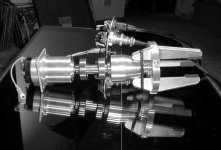
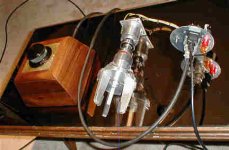
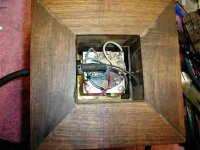
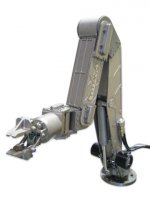

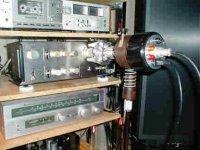
 I LOVE IT!
I LOVE IT!